Vermes
Advanced Member level 4

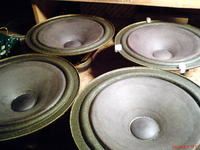
This method of regeneration is worked out, well thought, and despite apparent difficulty – easier than many other methods.
It starts with a speaker for the regeneration of the upper suspension.
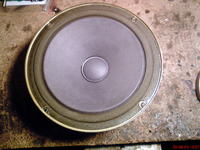
Sponge is quite 'dried' and it crumbles when touched. In this photo-report, GDN 20/30 speakers are shown, but the technology can be easily used in any others with similar construction.
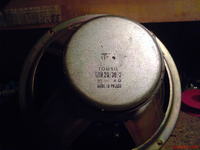
What is needed:
- acetone in a clear bottle, because acetone should be perfectly clear – any yellowing of the liquid indicates the pollution (mostly oily)
- disposable syringe with a piece of 'shirt' instead of a needle
- scissors
- knife
- insulating tape
- a piece of stiff wire
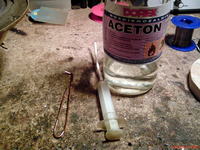
Firstly, membrane should be separated from the basket, which means cutting what hasn't been crushed yet.
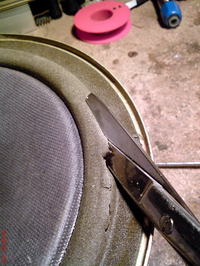
Re-soldering the strings linking the coil with the connectors:

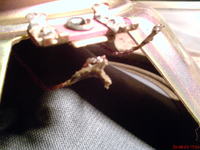
Then, lower spring should be detached. A shapely hook should be formed from piece of wire. The edge of the lower spring should be wiped around with a syringe. You shouldn't worry that it seeps into 'the whole' – the most important is that all the time the edge is moisturised. Few drops of acetone should be supplemented where it evaporates. After several minutes, the end of the hook should be gently slid between the spring and the basket. Then, still gently with sensitivity, the spring should be detached from the basket:
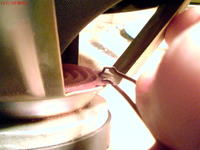
then the membrane with lower spring and strings from the basket should be pulled out. Take attention if nothing falls into the magnetic gap:
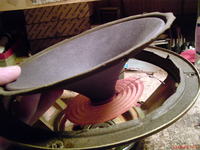
As shown, whole lower spring survived:
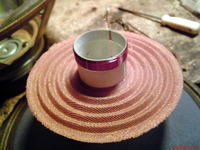
By the way, the state of coil can be evaluated if it doesn't look hot, detached or deformed. Then the slot should be sized tightly with insulating tape:
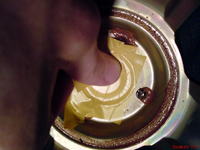
The rest of glue and rest of glue stuck with sponge should be wiped with acetone. It can now be applied by pieces. When the rest of glue gained desirable form, they can be separated calmly, piece by piece, from the basket. The target result of work should look like this:


Now the membrane should be cleared from pieces of old sponge. Firstly, counter-dust cover was peeled off.
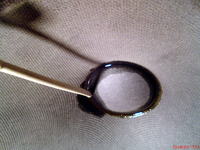
Few drops of acetone were applied on the membrane contact with the cover. Then it was covered with the membrane on the coil (this would reduce unnecessary evaporation of acetone). It was also supplemented few times with acetone which evaporates anyway. After five minutes, the cover should be gently detached from the membrane:

The rest of glue should be separated from the membrane and the cover:
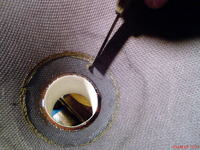
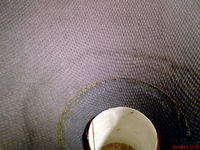
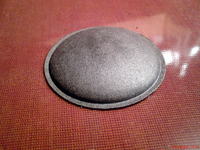
The rest of sponge should be treated like this:
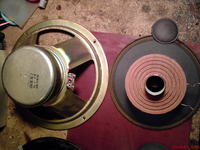
In the same way the rest of depolymerised sponge and glue should be deleted from the membrane. Do it on flat surface, pay attention not to crush the membrane, cut it and not to delete too much.

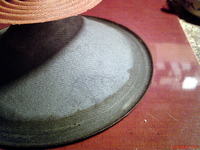
The result shown above is satisfying.
Now, it is time to prepare upper spring (original one), a stiff brush and glue. The best is glue for speakers regeneration BUTAPREN PLUS (PATTEX).
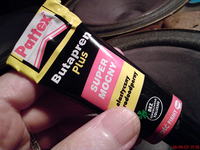
Glue was distributed with a stiff brush in a thin layer on the inside of the spring and the purfied membrane surface:


BUTAPREN glues best when it's dry. After few minutes the spring should be put on the membrane lying on a flat surface. It ought to be done carefully and with precision. Both surfaces were pressed, considering that nothing has moved an not crush.

Because the lower suspension wasn't changed, there is no need to worry about coil set in vertical (in the middle of the gap). BUTAPREN PLUS was applied on surface of the basket and lower suspension (spring) in the place when they come into contact with each other. The same with the upper part of the basket and inner surface of the sponge. A piece of film prepared before should be placed inside the coil before drying and submitting.

The film should be of suitable size (assembled to the magnetic circuit, the movement of the coil should be effectively impeded) and the length (first to enter the gap is the film and the coil with the membrane to be pushed down only when the lower edge of the film firmly touches the bottom of the magnetic system). As precise as possible, the coil is slide down the gap. Pay attention whether the links leading voltage to the coil were in the right place. A millimetre before touching the lower spring with the basket, check once again if everything is in the right place (strings, upper spring, film) and as it was in sticking upper suspension to the membrane, stick upper spring to the collar of the basket. The whole can be pressed for example with an pencil with an eraser at the end. It should dry about 12 hours.
After that time, film should be gently removed. Then the cover was prepared to be glued on the right place.
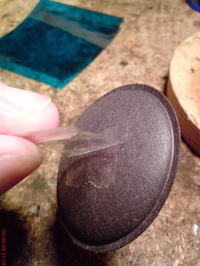
A piece of Scotch tape was attached to the cover in a way that there is an element to handle. A surface that is to be glued to the cover, should be previously put to a fabric. This would weaken the connection because of the fragments of fabric's strings, so that the tape could be removed easily after sticking. A thin layer of glue was then put on the membrane and on the surface of the cover's collar. This time 'wet' pressing in the suitable places, take off the tape and leave to dry. After another 12 hours strings were soldered again to the connectors and finished with BUTAPREN.
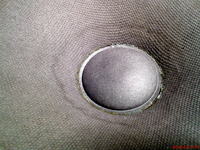
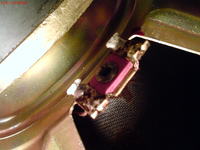
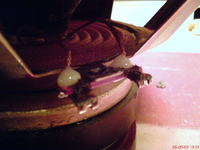
Now, when all is done, the device works properly. You must of course wait for the volatile fraction of glue to dry, to reach full power.
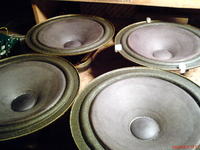
Link to original thread – Regeneracja GDN 20/30 - Fotorelacja (Jak ja to robię)